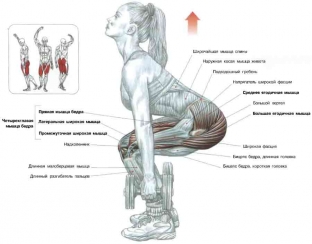Any workout should be beneficial and healthy. Squats not only help fight excess weight and cellulite, but also create excellent muscle relief and elastic buttocks. There are many types of squats. You can choose any, it all depends on the load and what kind of sport you do. Why include these exercises in your workout? What muscles are squats targeted at? What is the benefit of this type of load? Can everyone squat and how to do it correctly?
What are the Benefits of Squats?
Squats can be performed both under the weight of your own body and with weights (dumbbells, kettlebell, barbell). It all depends on your preparation. Consider the main points, what are the benefits of squats:
- Blood circulation in the pelvic area increases, due to this, microcirculation in all tissues of this area improves. The skin becomes firmer, cellulite is reduced;
- During squats, the abdominal and back muscles also work, they help to maintain the correct posture;
- Doing squats gives you a full cardio load;
- Movement coordination improves due to muscle strengthening;
- They help to maintain endurance, if you constantly engage in this type of load, then long walks or running in heels will not be a problem for you, your legs will not hurt. You will also be able to handle outdoor games like football, basketball, etc.;
- Improve metabolism, accelerate metabolism, due to which excess fats are burned and kilograms go away;
- For those involved in strength sports, this is a great way to increase body mass;
- As mentioned, squats work your abs just as well as crunches. Accordingly, your tummy will always be taut;
- Excellently develop joints (hip, knee and ankle), making them work correctly. Therefore, traumatism during power loads is reduced;
- This type of exercise can be done anywhere and anytime. It does not require the use of special tools and additional costs.

Are there any contraindications for this load?
We figured out the benefits of squats. But it is important to know that this load has a number of contraindications. In order not to harm your body, you should know that:
- Problems with the spine (hernias, sciatica, etc.);
- Varicose veins;
- Chronic cardiovascular diseases;
- Difficulties with knee or ankle joints;
require expert advice. Only he will be able to tell you what is right for you and whether it is possible to perform these exercises at all.
What are the main types of squats?
Once we have established the benefits of squats, let's look at the types of squats, and you can choose which one is most suitable for you.
- Classic (put feet shoulder-width apart, hands forward or on the belt)
- "Plie" (legs spread wide, toes apart, slowly squat until the thighs are parallel to the floor. Slowly rise. Performing this exercise, the femininity of the forms is preserved);
- "Scissors" (for starters, this exercise is performed with emphasis on the back of a chair or a stick. Focus on one leg, set the other back. We start to squat, the leg is bent, but you don’t need to touch the floor. This exercise is also good for developing coordination of movements. Do 10- 15 times for each leg);
- "At the Wall" (cling tightly to the wall, we begin to squat. We do not tear our back from the wall, we reach a position where the legs are 90 degrees to the floor. Stay in this position for as long as possible. Get up to the starting position);
- You can squat with weights, but the weight must be added gradually. Ultimately, it should not exceed 15 kg.)
Always try to keep your back straight so that the load on the joints and spine is distributed correctly. Do not squat too deep, thighs should be parallel to the floor. Don't lift your heels off the floor. You need to do the exercise on the exhale, rise – on the inhale. The noma for beginners is 10-40 squats, but can be split into multiple sets.
Now that you have learned the benefits of squats, feel free to include them in your training with estet-portal.com.






Add a comment